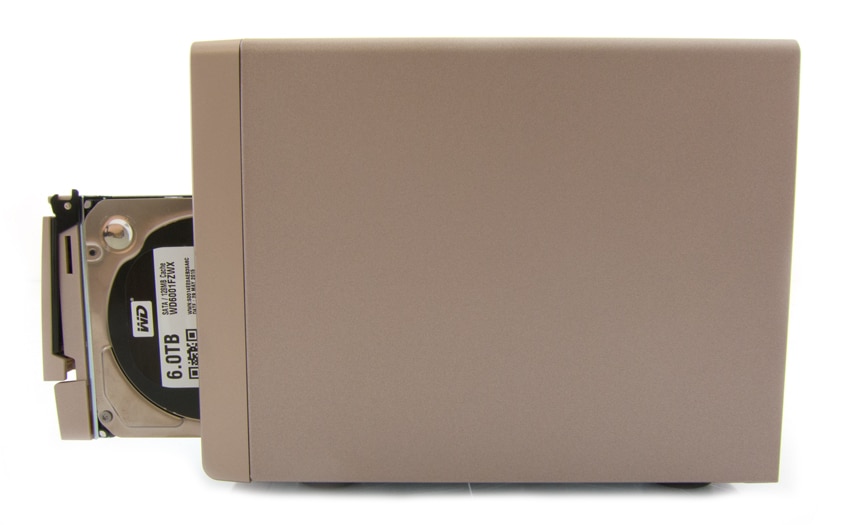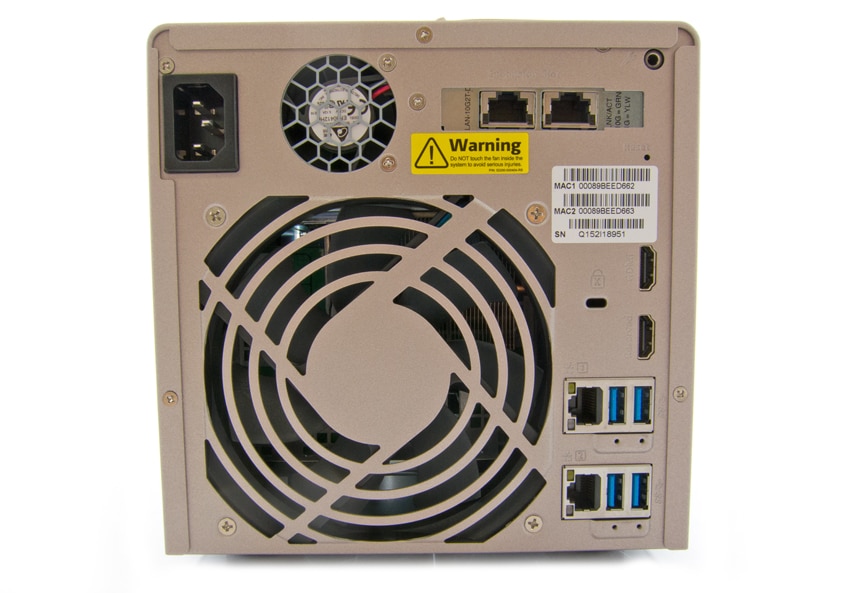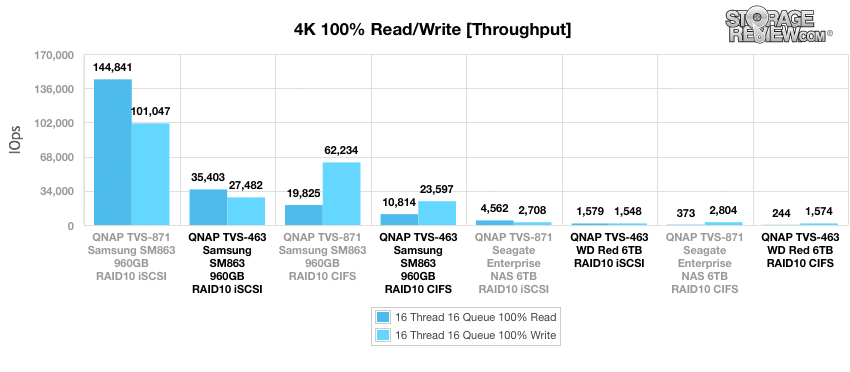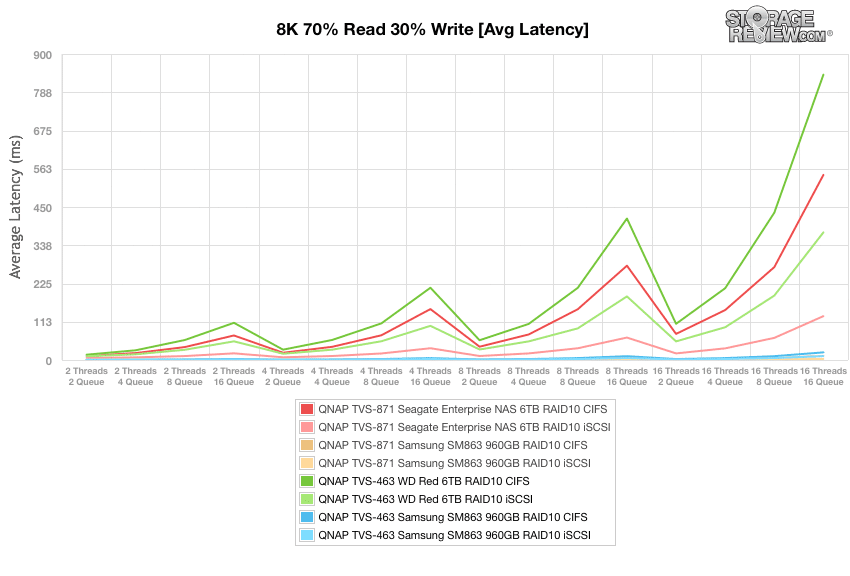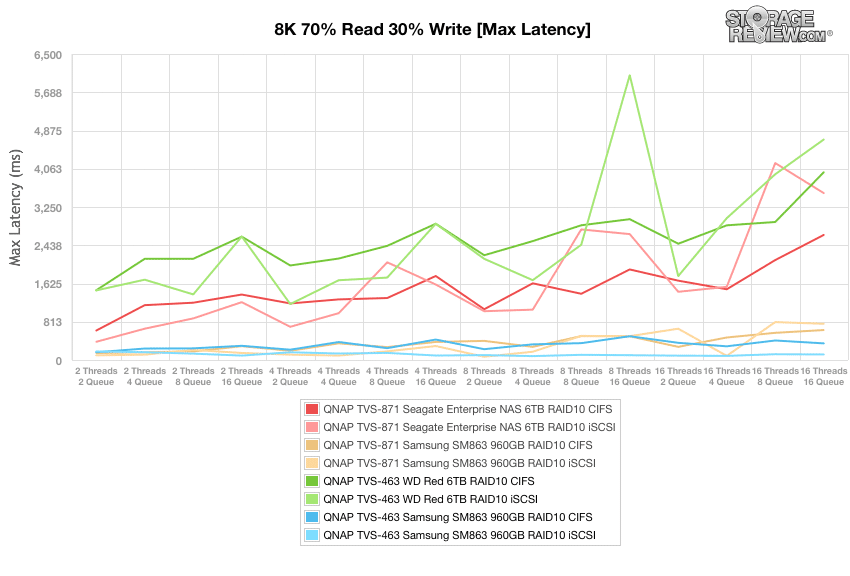
The TVS-463 is a NAS solution designed for home to business applications with the ability to expand the total raw storage capacity up to 160TB using the UX-800P QNAP expansion enclosure. In addition, the TVS-463 is 10GbE-ready when using the optional PCI-E network expansion, which allows for high performance and persistent throughput. The TVS-463 comes equipped with a AMD 2.4GHz quad-core x86 processor with 4GB DDR3L-1600 RAM (upgradable to 16GB) as well as five USB 3.0 ports, two HDMI ports, and two Gigabit LAN Ports. This functionality allows the TVS-463 to be used as a PC via its QvPC Technology; users simply plug in a monitor, keyboard and mouse and they are now able to operate the NAS using HybridDesk Station on the screen. Users can also run multiple Windows, Linux, Android-based virtual machines with the Virtualization Station.

QNAP quotes their new NAS upwards of 425MB/s for both read and write activity using four GbE port configuration, and up to 1,481MB/s using the 10GbE configuration. The TVS-463 also uses a hardware-accelerated encryption engine, allowing them to quote some pretty good encryption performance (up to 686MB/s with AES-256 bit full NAS volume encryption), a feature the is very important SMBs . In addition, the TVS-463 is equipped with next-gen AMD Radeon HD graphics with hardware-accelerated transcoding performance and HD video editing and sharing as well as HD playback via its two HDMI ports. The QNAP NAS also has an optional Wi-Fi 802.11ac USB network adapter.
The TVS-463 is also compatible with the latest version of QNAP’s QTS Smart NAS Operating System (4.1), which offers a user-friendly interface for system operations of the NAS. The QTS OS provides users with multimedia applications for photos, music, and videos as well as the ability to create desktop shortcuts or group shortcuts, monitor important system information on a real-time basis, and open multiple application windows to run multiple tasks concurrently.
The QNAP TVS-463 is available in two configurations: the TVS-463-4G (4GB DRAM) and the TVS-463-8G (8GB RAM), which are available for roughly $799 and $859 respectively. We will be looking at the TVS-463-8G unit.
QNAP TVS-463 Specifications
- CPU: AMD 2.4GHz quad-core x86 processor with Radeon graphics
- DRAM
- TVS-463-4G: 4GB DDR3L-1600 x 1
- TVS-463-8G: 8GB DDR3L-1600 x 1
- Total memory slots: 2
- Memory expandable up to: 16 GB (8GB x2)
- Flash Memory: 512MB DOM
- Hard Disk Drive: 4 x 3.5”or 2.5”SATA 6Gb/s, SATA 3Gb/s hard drive or SSD
- Hard Drive Tray: 4 x Hot-swappable tray
- LAN Port
- 2 x Gigabit RJ-45 Ethernet port (Onboard:2, expandable to max 4 ports via PCI-E NIC)
- PCIe Slot : 1 (PCIe Gen2 x 4)
- LCD Panel:
- Mono-LCD display with backlight, Enter and Select buttons for configuration
- LED Indicators Power, Status, LAN, USB, HDD 1-4
- USB: 5 x USB 3.0 port (Front: 1, Rear: 4)
- Support USB printer, pen drive, and USB UPS etc.
- HDMI: 2 (Mirrored Display), 1.4a
- Note: 4K video playback and transcoding are not supported
- Buttons : Power/Status, USB One-Touch-Backup, reset
- Alarm Buzzer : System warning
- IR Receiver
- QNAP RM-IR002 and MCE-compatible remotes
- Tower Dimensions
- 177(H)x 180(W) x 235(D) mm
- 6.97(H) x 7.09(W) x 9.25(D) inch
- Weight Net: 4.56 kg (10.05lbs)
- Gross: 5.70 kg (12.57lbs)
- Power Consumption(W) S3 sleep: 2.26W
- HDD standby: 34.77W
- In operation: 50.38W (with 4 x 2TB HDDs installed)
- Temperature: 0-40˚C
- Humidity: 5~95% RH non-condensing, wet bulb: 27˚C
- Power Supply: ATX 250W, 110-240V AC, 50-60Hz, 5A
- Physical Security: Kensington security slot for theft prevention
- Fan: 1 x quiet cooling fan (12 cm, 12V DC)
Design and build
The sleek looking QNAP TVS-463 is built with a metal frame and metal parts, and is very sturdy and rugged when handled. Branded with the company logo at the top left, the TVS-463 is comprised of a tower form factor with a silver/white plastic chassis cover. The front of the NAS is host to four hotswappable drive bays, each of which have a locking mechanism as well as the LCD display panel, providing users with quick system information using the Enter and Select button to the right. The Status, USB, and LAN LED indicators are located just below.
Also located on the front panel is a Power button, USB 3.0 port and the One Touch Copy button, the latter which backs up data from the front USB drive to the NAS or vice versa.
When looking at the rear-side panel, you will immediately notice QNAP’s newly-designed heat sink, which exhausts excessive heat. To the right of the fan are two HDMI, four USB 3.0, abd two Gigabit LAN ports, as well as the Kensington Security slot for increases physical security. The Power Connector, Console port, PCIe Expansion slot, and Password and Network Setting reset button are all located along the top of the device.
Testing Background and Comparables
We publish an inventory of our lab environment, an overview of the lab’s networking capabilities, and other details about our testing protocols so that administrators and those responsible for equipment acquisition can fairly gauge the conditions under which we have achieved the published results. None of our reviews are paid for or overseen by the manufacturer of equipment we are testing.
We tested both SMB and iSCSI performance using RAID 10 configurations of the WD Red NASware 3.0 6TB and Samsung SM863 drives, which we will be comparing it to QNAP’s TVS-871 NAS solution using the same drives.
Our standard StorageReview Enterprise Test Lab regimen runs the device through its paces with a battery of varying performance levels and throughput activity workloads. For the QNAP TVS-463, the following profiles were utilized to compare performance between different RAID configurations and different networking standard protocols (SMB and iSCSI):
- 4K 100% Read / 100% Write throughput
- 8K 100% Read / 100% Write throughput
- 8K 70% Read / 30% Write throughput
- 128K 100% Read / 100% Write throughput
Our first benchmark measures the performance of random 4k transfers comprised of 100% write and 100% read activity. Here, the TVS-463 posted its best read throughput of 35,403 IOPS when populated with the Samsung drive, which also had its best write throughput as well (27,482 IOPS). In comparison, the higher classed TVS-871 showed its best performance with the Samsung drive as well, with 144,841 IOPS read and 101,047 IOPS read.
Looking at average latency, we see the TVS-463 showing 7.23ms read and 9.31ms write with the Samsung SM863 SSD (iSCSI). In CIFS, the TV-463 boasted read and writes of 23.67ms and 10.85ms with the Samsung drive.
The maximum latency showed top performance of the TVS-463 with 43.2ms read and 288.1ms in iSCSI connectivity; however, the CIFS wasn’t far behind with 85ms read and 299.2ms write.
In our standard deviation section of the 4k test, which gives us a good visualization in terms of consistency, we see the TVS-463’s best performance at 6.46ms read and 11.07ms write during the iSCSI block-level test.
The next test again puts the drives under 100% read/write activity, this time at 8K sequential throughput. Here, the TVS-463 showed boasted its top read and write performance under CIFS with the WD Red 6TB, posting 42,873 IOPS read and 30,029 IOPS write, though iSCSI configurations weren’t far behind.
Compared to the fixed 16 thread, 16 queue max workload we performed in the 100% 4k write test, our mixed workload profiles scale the performance across a wide range of thread/queue combinations. In these tests, we span workload intensity from 2 threads and 2 queue up to 16 threads and 16 queue. Looking at throughout, the TVS-463 showed its best performance with the iSCSI connectivity with the Samsung drive; however, CIFS showed the most consistent performance of all configurations and NAS devices.
With average response times, we see very similar results between the TVS-463 and the TVS-871 when configured with the Samsung SSDs, posting very little latency.
Looking at max latencies, the TVS-463 had the best overall performance when leveraging iSCSI with the Samsung drives.
Standard deviation gave us virtually identical results to average latency, posting its best performance when configured with the Samsung SSDs via iSCSI.
Our last workload in our small NAS Synthetic Workload testing consists of the 128k test, which is a large block sequential test that shows the highest sequential transfer speed. When looking at the 128k performance of 100% write and 100% read activity, the TVS-463 boasted its top read speed of 1,111,552KB/s with iSCSI using the Samsung drives, narrowly beating out the WD Red configuration (CIFS), which had a read speed of 1,083,904KB/s.
Conclusion
The QNAP TVS-463 is a 4-bay tower form factor NAS that is powered by an AMD 2.4GHz quad-core x86 processor with Radeon graphics and 8GB of DDR3L-1600, which is expandable up to 16GB. Its total raw storage capacity is capable of reaching up to a 160TB of data using the UX-800P QNAP expansion enclosure and is 10GbE-ready with the optional PCI-E network expansion. This allows the QNAP NAS to achieve high performance I/O and throughput. It is also equipped with a plethora of connectivity, with five USB 3.0 ports, two HDMI ports, and two Gigabit LAN Ports, giving users the ability to use the NAS as a PC through its QvPC Technology. All you have to do is simply plug in a monitor, keyboard, and mouse and you can operate the NAS using HybridDesk Station. This is certainly a very versatile NAS.
To measure its performance, we tested both CIFS and iSCSI protocols using RAID 10 configurations with the WD Red NASware 3.0 6TB and Samsung SM863 drives. For our 4k tests we saw throughput as high as 35,403 IOPS read and average latency as low as 7.23ms read, both of which leveraging the Samsung drive via iSCSI. Our sequential 8k test showed a throughput of 42,873 IOPS read and 30,117,622 IOPS write when using the WD Red (CIFS) and SM863 (CIFS) respectively. Looking at large block sequential we saw read speeds at 1,111.6MB/s while writes speeds of 982.4MB/s under CIFS using the Samsung drives. Overall, we saw some fantastic performance, especially when looking at average response times; even the HDD configurations with the WD Red recorded impressive results in some of our workloads.
Pros
- Impressive overall performance in RAID10; low latency
- Rugged build quality
- Versatile; ability to use the NAS as a PC
Cons
- Not as fast as the TVS-871 with its Intel-based processor
Conclusion
The QNAP TVS-463 is a versatile 4-bay NAS that offers excellent performance for prosumers that demand high throughput and expansive storage potential from their NAS.
Sign up for the StorageReview newsletter

